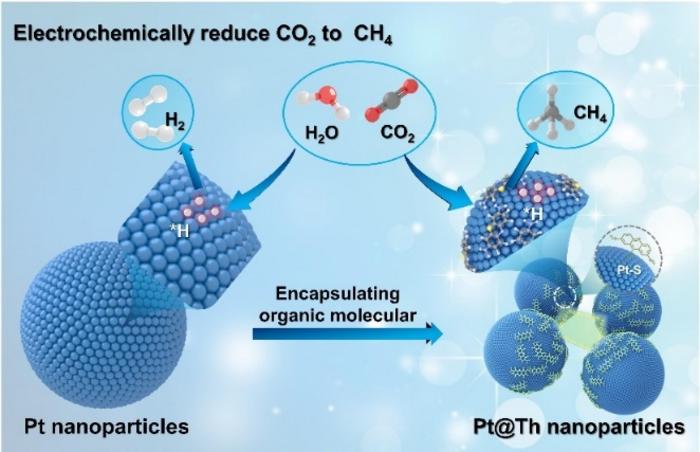Recent advances in the field of electrocatalysis have shed light on a revolutionary approach to transforming carbon dioxide (CO2) into methane (CH4) using a modified platinum (Pt) surface. The study, led by a research team at a prominent institution, focuses on a novel method of molecular modification that enhances the catalytic efficiency while significantly suppressing competing reactions, particularly the hydrogen evolution reaction (HER). This breakthrough could pave the way for more effective carbon capture technologies and sustainable energy production methods.
The need for efficient CO2 conversion strategies is more pressing than ever, primarily due to the increase in greenhouse gas emissions attributed to industrial and agricultural activities. Traditional copper-based catalysts have shown promise in converting CO2 into valuable hydrocarbons through the CO2 reduction reaction (CO2RR). However, their performance in acidic environments is often hampered by insufficient stability. Conversely, platinum is renowned for its excellent durability and resilience in varying pH conditions, making it an ideal candidate for enhancing CO2RR processes.
Yet, the competitive activity of Pt in HER has posed a significant challenge. This dual activity of Pt often leads to decreased efficiency when aiming for selective CO2 conversion. Therefore, researchers have focused on innovative methodologies to reduce the HER activity while promoting the desired CO2RR. One such promising approach involves constructing composite materials that leverage metal-doped molecules to create more effective catalysts.
The research team, led by Professor He, employed a sophisticated molecular doping technique that incorporates thionine (Th) molecules within platinum nanocrystals. This approach results in the creation of a hybrid catalyst known as PtNPs@Th, where the thionine molecules are encapsulated around the platinum nanoparticles. The strategic arrangement of Th molecules significantly modifies the surface properties of Pt, thus enhancing its catalytic profile for CO2RR while effectively inhibiting HER activity.
In acidic environments with varying pH levels, PtNPs@Th catalysts demonstrate remarkable stability and efficiency. The encapsulated thionine molecules act as a stabilizing agent, facilitating prolonged catalytic action without degradation of performance. This discovery is particularly notable as it allows for efficient CH4 production from CO2 even in highly acidic solutions, making it a promising candidate for practical applications in carbon capture and renewable energy systems.
The team conducted comprehensive in-situ characterizations and theoretical calculations to elucidate the mechanism by which PtNPs@Th enhances the conversion of CO2 to CH4. Their findings reveal that the synergistic interaction between thionine and the Pt surface creates ideal conditions for the selective adsorption of critical intermediates involved in CO2RR. This increased interaction between reactants and active sites on the catalyst surface plays an essential role in fine-tuning the catalytic activity and efficiency.
Moreover, maintaining catalytic stability over extended periods is critical for any commercial application. The PtNPs@Th catalysts have shown exceptional resistance to corrosion and a sustained catalytic performance exceeding 100 hours in acidic environments. This durability represents a substantial improvement over existing catalysts that often fail under similar conditions, thereby underscoring the potential of molecularly engineered catalysts in practical applications.
In addition to this research, there is an increasing push within the scientific community to explore the integration of these advanced catalysts into larger systems capable of capturing and converting CO2 at scale. This integration would not only enhance the efficiency of industrial processes but also contribute to creating closed-loop systems for carbon management.
The broader significance of this work also lies in its contribution to the field of sustainable energy. By enhancing the production of methane—a high-energy fuel from CO2—techniques such as this could play an integral role in transitioning away from fossil fuels. Methane, being a cleaner-burning fuel, could serve as an intermediary energy source that facilitates the shift toward renewable energy solutions.
The findings of this study are poised to stimulate further research in molecular modifications for electrocatalysis, providing a framework for the development of new materials and strategies to tackle the pressing challenge of climate change. As researchers continue to delve into the intricate mechanisms of electrocatalysis and explore novel catalyst designs, the potential for high-efficiency carbon conversion technologies becomes increasingly attainable.
Each step taken by scientists in this domain reaffirms the importance of innovation and interdisciplinary collaboration in addressing global energy challenges. The continued refinement of CO2RR catalysts, particularly with advances in molecular engineering, is key to unlocking the full potential of electrocatalysis in the quest for sustainable energy solutions.
As this research gains traction, it is likely to influence various sectors, from energy to environmental technologies, showcasing the critical role of scientific inquiry in shaping a sustainable future.
Subject of Research: CO2 electroreduction to methane using modified platinum catalysts
Article Title: Molecular Modification Enables CO2 Electroreduction to Methane on Platinum Surface
News Publication Date: October 2023
Web References: DOI
References: National Science Review
Image Credits: ©Science China Press
Keywords
Electrocatalysis, CO2 Reduction, Methane Production, Platinum Catalysts, Renewable Energy, Carbon Capture, Molecular Engineering, Thionine, Sustainable Technologies.





